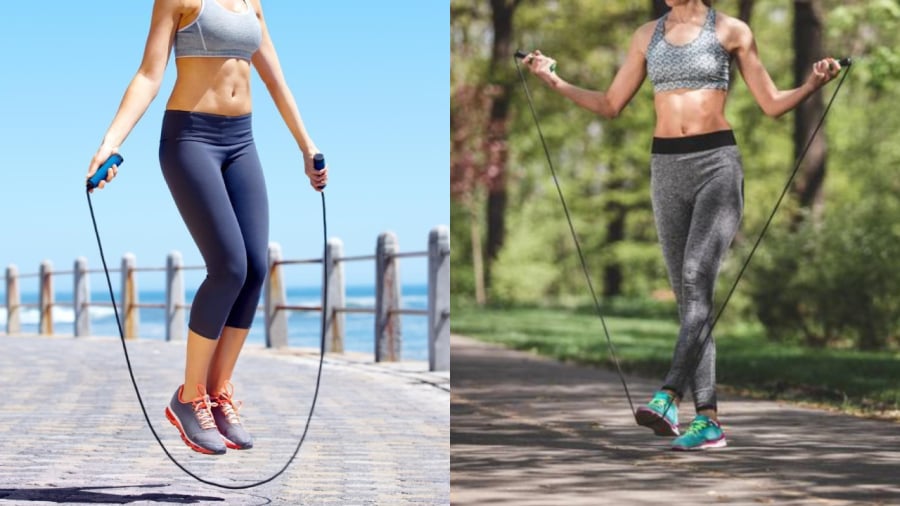Can Jumping Rope Help with Weight Loss?
Jumping rope is a popular form of exercise because it doesn’t require expensive equipment, can be done anywhere, and provides great results. Jumping rope not only helps burn excess fat and aids in weight loss, but it also improves body flexibility.
When jumping rope, various parts of the body such as the legs, glutes, thighs, and abdomen are heavily impacted. These parts, when fully engaged, help burn a significant amount of energy and thus facilitate effective weight loss.
Jumping rope also contributes to improving cardiovascular function and enhances the body’s metabolism.

Jumping rope correctly can help with weight loss.
Does Jumping Rope Make Your Calves Bigger?
When jumping rope, the muscle groups in the legs are heavily impacted. The thighs and calf muscles are particularly affected due to the impact force from the feet and the pressure exerted by the knees during the jumping process. As a result, the leg muscles develop and become more toned. After jumping rope for a while, you will notice that your legs become firm and you can feel the muscles becoming more prominent.
Many people are concerned that jumping rope will make their calves bigger. However, jumping rope correctly does not make the calves bigger; instead, it develops the leg muscles to a certain extent, making them firmer without excessive size increase.
Types of Jumping Rope
– Two-footed Jump: This is the most basic and easiest way to jump rope, and it reduces the risk of knee injuries. Landing on both feet will allow you to increase your jumping speed easily. Increased jumping speed also helps burn more calories.
– Stationary Jump: When jumping, you need to kick one foot backward while the other foot jumps over the rope. This is a suitable jumping style for beginners.
– Jogging Jump: This jumping style can impact the leg and thigh muscles while also tightening the glutes and abs. You can raise your knees during the jumping process to increase the difficulty of the exercise.
Considerations When Jumping Rope
– Choose the right jump rope
You should choose a jump rope with a length suitable for your height, neither too short nor too long. To check if the rope is suitable for you, hold the handles of the rope (one handle in each hand as if preparing to jump). Step on the middle of the rope and pull it tight. If the two handles are level with your armpits, then the jump rope is suitable for you.
– Choose appropriate shoes
Shoes are important for the training process. You should choose a pair of well-fitting shoes made of soft and breathable material to avoid foot pain.
– Timing
Avoid jumping rope when you are too full or too hungry. It’s best to jump rope about 90 minutes after a meal.
– Warm-up
Before jumping rope, you need to warm up properly to avoid injuries. Spend about 5 minutes doing warm-up exercises before jumping rope.
– Maintain the training
You should jump rope at least 3 sessions per week, 20-30 minutes per session. Initially, you can start with short jumping times, low jump rates, and slow speeds, then gradually increase as you get used to it.
- Two-footed Jump: This basic technique reduces the risk of knee injuries and allows for easier speed control. Landing on both feet helps increase jumping speed and calorie burn.
- Stationary Jump: This style involves kicking one foot back while the other foot jumps over the rope. It is suitable for beginners.
- Jogging Jump: This technique targets the leg and thigh muscles, while also tightening the glutes and abs. Raising the knees during the jump increases the difficulty level.
- Choose the right jump rope: Ensure the rope length is suitable for your height. Hold the handles and step on the middle of the rope. If the handles reach your armpits, it’s the right size.
- Wear appropriate shoes: Opt for well-fitting, soft, and breathable shoes to prevent foot pain.
- Timing: Avoid jumping rope when you’re too full or hungry. The ideal time is about 90 minutes after a meal.
- Warm-up: Warm up for about 5 minutes before jumping rope to prevent injuries.
- Maintain a consistent training schedule: Jump rope at least 3 times a week for 20-30 minutes each session. Start with shorter durations and slower speeds, gradually increasing as you get comfortable.



































